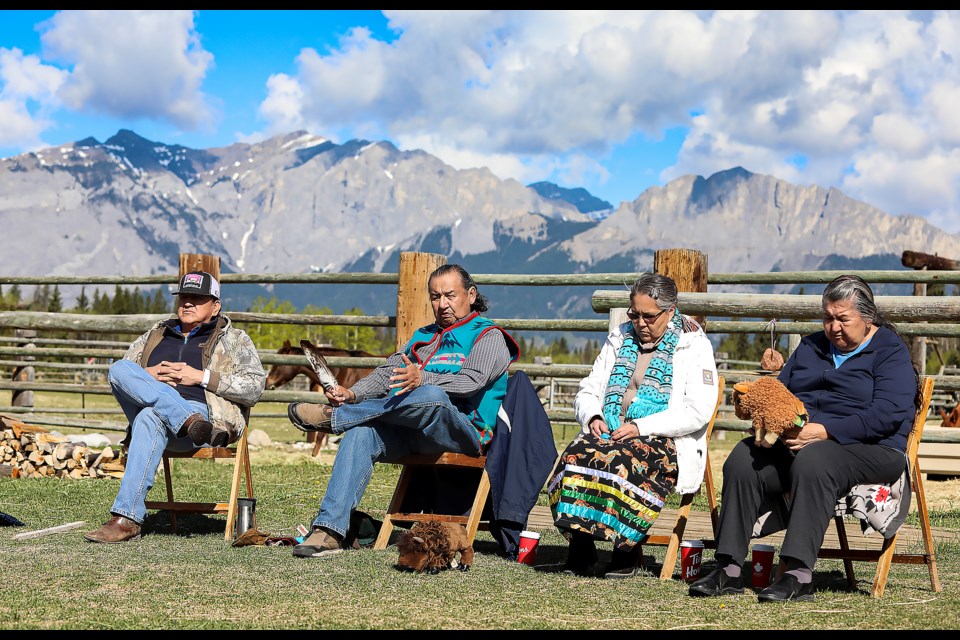ÎYÂRHE NAKODA – Like Walking Buffalo, who travelled the world to share Indigenous culture and ways of knowing, Îyârhe (Stoney) Nakoda elders still carry that tradition today with the animal for whom the former Bearspaw chief was named.
Last week, Grade 5 classes from Bow Valley schools gathered at Star 6 Ranch near Exshaw, where they listened to and learned from four elders about the ecological and cultural significance of bison – a keystone species to the area.
“This area is traditional ground. Here, we used to do ceremonies, sun dances. We dance for the buffalo and all the other animals that looked after us,” said Îyârhe Nakoda Elder and knowledge keeper Philomene Stevens, whose traditional name is Mackochi Weya (Mother Nature), to students from Exshaw School and Lawrence Grassi Middle School.
The Îyârhe Nakoda, along with many other Indigenous cultures, honour the animal having long relied on it to supply everything from food and shelter to clothing and tools before it was hunted to the brink of extinction by colonizers who sought to harm the land's Indigenous peoples and their ways of life.
“We have names for every part of the buffalo, even on the inside. We don’t waste anything, and we have carried that on from our ancestors and our grandparents,” said Stevens.
In partnership with the Biosphere Institute of the Bow Valley, students learned not only the significance of each part of the animal, but also the names of those parts in different Indigenous languages, including Stoney, and the history of how the animal’s presence affects the landscape for the betterment of all species.
The event’s curriculum was designed differently across schools, some of which have a higher percentage of Indigenous or non-Indigenous students, culminating in a field trip where they could also learn from each other in a cross-cultural setting.
“Canmore students learned about the ecological significance and history of bison on the landscape and how the animal, as a keystone species, has affected the landscape,” said Heidi Widmer, environmental educator with the Biosphere.
Exshaw students, on the other hand, were visited by elders and knowledge keepers in March, where the focus was more on language and traditional uses of different parts of the bison.
The learning format was inspired by Mi’kmaw Elder Albert Marshall, who coined the concept of ‘two-eyed seeing.’
“This is when we’re blending Indigenous ways of knowing if you can imagine you’re seeing that through one eye, and through the other eye you’re seeing the western perspective,” said Widmer.
“When we combine the two, that’s where we have a more complete version of understanding.”
The concept also promotes relationship-building across schools.
Landis Burr, a Grade 5 teacher at Nakoda Elementary School, which participated in the event earlier in the week with Banff Elementary School, said their Indigenous student body took a lot of pride in being able to share all they learned from the elders and knowledge keepers.
“They’re already pretty familiar with those sorts of protocols and things like that, so they were really proud to share that piece of their lives with other kids,” said Burr.
Sharing knowledge among their community and with neighbouring communities is part of the Îyârhe Nakoda way, said Virgil Stephens, a knowledge keeper of the First Nation.
With more newcomers to Canmore, Banff, Exshaw and Cochrane every year, the elder believes it’s more important than ever to continue this tradition.
“It’s up to us to let the next generation carry this knowledge. It’s part of our ways – teaching; to honour our ancestors, like this guy did,” he said, pointing to a $5 Cochrane Dollar bill – used in a local currency program – with a picture of Chief Walking Buffalo.
Widmer added it’s important for students to learn the ecological and cultural history of the land so they can act on its behalf.
In the Banff National Park area, bison didn’t roam in the vast herds that were common on the plains, but even in low numbers they helped shape ecosystems as the historically dominant grazers.
Elder and knowledge keeper Ollie Benjamin said he was pleased to see bison reintroduced to the national park in 2017. The Panther Valley herd’s resurgence, he noted, is evidence of their belonging and importance on the landscape.
“We went back there to check on those buffalo a while ago and they had [more than] tripled from a herd of 16 to 84,” he said. “It just goes to show how much they can come back.’"
The Local Journalism Initiative is funded by the Government of Canada. The position covers Îyârhe (Stoney) Nakoda First Nation and Kananaskis Country.




